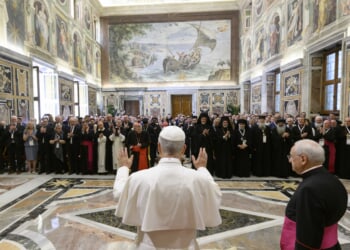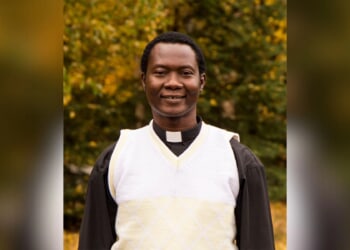While the rainbow war banners of Pride Month have dominated June over the past several years, immigration raids, riots, airstrikes in the Middle East, and a host of significant U.S. Supreme Court decisions have shifted the focus this year. Nevertheless, LGBT Pride parades still cropped up in Chicago, Denver, Los Angeles, New Orleans, New York City, Philadelphia, San Francisco, and Washington, D.C.
If loneliness and solitude stab one’s heart, who better would understand than One whose Heart is pierced with a lance?
“Love is love,” say LGBT activists in defense of their disordered desires. Yet there is more truth — and certainly a much different truth than is intended by those who sling the slogan about — in this seemingly trite maxim, and the Sacred Heart of Jesus is the ideal place to find that truth. In fact, the Sacred Heart is the ideal antidote to the perversions of Pride Month. When the French St. Margaret Mary Alacoque was visited by Christ in the late 17th century, she no doubt did not envision that the devotion that He shared with her and that she so lovingly embraced would, a few centuries later, become the chief opponent of a near-global agenda to normalize and glorify sexual degeneracy and depravity, but Christ certainly knew.
Between December of 1672 and June of 1675, Christ appeared to Alacoque on numerous occasions. In the first apparition, He invited her to rest her head on His Sacred Heart. However, the Son of God was increasingly saddened in subsequent apparitions by the sins of mankind. Alacoque wrote in her autobiography, “Jesus spoke of the sadness He feels because His great love for humanity receives in exchange ‘nothing but ingratitude and indifference,’ ‘coldness and contempt.’ And this, He added, ‘is more grievous to me than all that I endured in my Passion.’”
Based on Alacoque’s testimony, the Sacred Heart is depicted as a heart crowned with thorns, pierced in the side with a lance, topped with a cross, and set ablaze with fire. Even before Christ appeared to Alacoque, Catholic Saints have written of Christ’s love in similar terms. St. Augustine, St. Justin Martyr, and St. Irenaeus all reflected on Christ’s great love for mankind, pointing to His suffering during His passion and death and likening His unstoppable love to an unquenchable fire. Later on, in the Medieval Ages, Saints such as Bernard of Clairvaux and Bonaventure would describe Christ’s heart as a fire or a furnace burning with love for the world.
LGBT activists frequently claim that they simply want to be “accepted” or “welcomed.” In Christ’s Sacred Heart, they will find that they are accepted and welcomed — and loved. But it is no accident that the Sacred Heart is on fire, that it is likened to a furnace. All those who enter in to the Sacred Heart will inevitably find themselves changed by that fire: sin, selfishness, and the desire to satisfy oneself will all be burned away. It will not be painless. In The Great Divorce, C.S. Lewis writes of an angel purifying a soul of lust, embodied as a lizard. When the bright, burning angel reaches out to kill the lizard, he burns the soul:
“Get back! You’re burning me. How can I tell you to kill it? You’d kill me if you did.”
“It is not so.”
“Why, you’re hurting me now.”
“I never said it wouldn’t hurt you. I said it wouldn’t kill you.”
The flames of the Sacred Heart may be as lashes or scourges or they may be as gentle kisses, but they will burn.
The Catechism of the Catholic Church instructs those afflicted with same-sex attraction not to act on their desires, to live chastely. Certainly, this may seem like a cruel hardship, simply a means of stripping pleasure and companionship from life. But the Sacred Heart shows otherwise. If a life of chastity is a thorn in one’s side, what better friend could one ask for than One who is crowned with thorns? If loneliness and solitude stab one’s heart, who better would understand than One whose Heart is pierced with a lance? If struggling against one’s own desires is a burden, who better to help bear that burden than One who has borne it already in His cross?
Again, whether it be geopolitical happenings, domestic unrest, or curtailed corporate sponsorship, this year’s Pride Month has been muted, compared to the recent past. But it may also just be that the Sacred Heart of Jesus is, very slowly, setting the world on fire with love.
READ MORE from S.A. McCarthy:
Catholicism Is Not a ‘Foreign Influence’ in America




![Man Arrested After Screaming at Senators During Big Beautiful Bill Debate [WATCH]](https://www.right2024.com/wp-content/uploads/2025/06/Man-Arrested-After-Screaming-at-Senators-During-Big-Beautiful-Bill-350x250.jpg)












